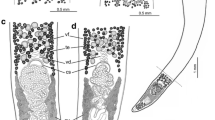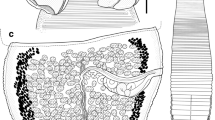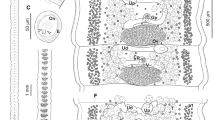Abstract
A new caryophyllidean cestode is described from barbs Puntius spp. (Cypriniformes: Cyprinidae), with P. sophore (Hamilton) as its type-host, in the Ganges and Brahmaputra river basins in India and Bangladesh, and a new genus, Lobulovarium n. g., is proposed to accommodate it. The genus belongs to the Lytocestidae because its vitelline follicles are situated in the cortex. It is typified by: (i) a peculiar ovary, which is roughly H-shaped, but with asymmetrical, irregular lobes on its ventral and dorsal sides; (ii) an extensive vitellarium formed by numerous vitelline follicles scattered throughout the cortex; (iii) a long, conical postovarian part of the body with numerous vitelline follicles; (iv) a broadly digitate scolex with a slightly protrusible central cone; (v) a single gonopore (male and female genital ducts open via a single pore and a common genital atrium is absent); and (vi) a small number of testes (< 60). Molecular data (partial sequences of the lsrDNA) indicate that Lobulovarium longiovatum n. sp. belongs among the most basal caryophyllidean cestodes, being unrelated to species from siluriform catfishes in the Indomalayan region. Paracaryophyllaeus osteobramensis (Gupta & Sinha, 1984) Hafeezullah, 1993 (syn. Pliovitellaria osteobramensis Gupta & Sinha, 1984) from another cyprinid fish, Osteobrama cotio (Hamilton), in Uttar Pradesh, India, is tentatively transferred to Lobulovarium as L. osteobramense (Gupta & Sinha, 1984) n. comb. It differs from L. longiovatum by having much smaller eggs (length <50 μm versus >90 μm in L. longiovatum), which are spherical (length/width ratio 1:1 versus 2.5–3:1 in the new species), and the presence of vitelline follicles alongside the ovarian lobes (almost completely absent in L. longiovatum).





Similar content being viewed by others
References
Ash, A., Scholz, T., Oros, M., & Kar, P. K. (2011a). Tapeworms (Cestoda: Caryophyllidea), parasites of Clarias batrachus (Pisces: Siluriformes) from the Indomalayan Region. Journal of Parasitology, 97, 435–459.
Ash, A., Scholz, T., Oros, M., Levron, C., & Kar, P. K. (2011b). Cestodes (Caryophyllidea) of the stinging catfish Heteropneustes fossilis from Asia. Journal of Parasitology, 97, 899–907.
Baylis, H. A. (1928). Some parasitic worms from Lake Tanganyika. Annals and Magazine of Natural History, Series 10, 1, 552–562.
Brabec, J., Scholz, T., Kráľová-Hromadová, I., Bazsalovicsová, E., & Olson, P. D. (2012). Substitution saturation and nuclear paralogs of commonly employed phylogenetic markers in the Caryophyllidea, an unusual group of non-segmented tapeworms (Platyhelminthes). International Journal for Parasitology, 42, 259–267.
Drummond, A. J., Ashton, B., Buxton, S., Cheung, M., Cooper, A., Heled, J., Kearse, M., Moir, R., Stones-Havas, S., Sturrock, S., Thierer, T., & Wilson, A. (2010). Geneious v5.3. http://www.geneious.com.
Dubinina, M. N. (1987). [Class tapeworms – Cestoda Rudolphi, 1808.] In: Bauer, O. N. (Ed.) [Key to the parasites of freshwater fishes of the USSR.] Vol. 3. Leningrad: Nauka, pp. 5–76 (In Russian).
Fischthal, J. H. (1951). Pliovitellaria wisconsinensis n. g., n. sp. (Cestoda: Caryophyllidea) from Wisconsin cyprinid fishes. Journal of Parasitology, 37, 190–194.
Fotedar, D. N. (1958). On a new caryophyllaeid cestode, Adenoscolex oreini gen. et sp. nov. from fresh-water fish in Kashmir, and a note on some related genera. Journal of Helminthology, 32, 1–16.
Froese, R., & Pauly, D. (2012). FishBase. World Wide Web electronic publication. www.fishbase.org, version (01/2012), Froese & Pauly Editors.
Goel, K. A. (1975). Physiology of digestion in Puntius sophore (Ham.). Proceedings of the Indian Academy of Sciences, 81B, 254–261.
Gupta, S. P., & Sinha, N. (1984). On three new species of caryophyllaeids from fresh water fishes of Lucknow. Indian Journal of Helminthology, 36, 73–80.
Hafeezullah, M. (1993). Caryophyllidean cestode fauna of India. Records of the Zoological Survey of India, Occasional Paper No. 157, 101 pp.
Hiware, C. J. (2003). On a new species of the genus Lytocestoides Baylis, 1928 (Cestoidea: Caryophyllidea: Lytocestidae) from a freshwater fish, Cirrhina mrigala (Hamilton). Proceedings of the 16th National Conference of Parasitology, Rohilkhand University, Bareily, pp. 124–131.
Hossain, M. A. R., & Wahab, M. A. (2010). The diversity of cypriniforms throughout Bangladesh: present status and conservation challenges. In: Tepper, G. H. (Ed.) Species diversity and extinction. New York: Nova Science Publishers Inc, pp. 143–182.
Katoh, K., Kuma, K., Toh, H., & Miyata, T. (2005). MAFFT version 5: improvement in accuracy of multiple sequence alignment. Nucleic Acids Research, 33, 511–518.
Kundu, D. K. (1985). On a new species of the genus Lytocestoides Baylis, 1928 (Cestoidea: Caryophyllidea: Lytocestidae) from a cobitid fish, Lepidocephalus guntea (Ham.) from West Bengal. Bulletin of the Zoological Survey of India, 7, 285–290.
Lakra, W. S., & Goswami, M. (2011). Development and characterization of a continuous cell line PSCF from Puntius sophore. Journal of Fish Biology, 78, 987–1001.
Mackiewicz, J. S. (1968). Two new caryophyllaeid cestodes from the spotted sucker, Minytrema melanops (Raf.) (Catostomidae). Journal of Parasitology, 54, 808–813.
Mackiewicz, J. S. (1972). Caryophyllidea (Cestoidea): a review. Experimental Parasitology, 31, 417–512.
Mackiewicz, J. S. (1981). Synoptic review of the Caryophyllidea (Cestoidea) of India, Pakistan and Nepal. Himalayan Journal of Science, 1, 1–14.
Mackiewicz, J. S. (1994). Order Caryophyllidea van Beneden in Carus, 1863. In: Khalil, L. F., Jones, A., & Bray, R. A. (Eds.) Keys to the cestode parasites of vertebrates. Wallingford, UK: CAB International, pp. 21–43.
Mackiewicz, J. S., & Blair, D. (1980). Caryoaustralus gen. n. and Tholophyllaeus gen. n. (Lytocestidae) and other caryophyllid cestodes from Tandanus spp. (Siluriformes) in Australia. Proceedings of the Helminthological Society of Washington, 47, 168–178.
Mackiewicz, J. S., & McCrae, R. (1962). Hunterella nodulosa gen. n., sp. n. (Cestoidea: Caryophyllaeidae) from Catostomus commersoni (Lacépède) (Pisces: Catostomidae) in North America. Journal of Parasitology, 48, 798–806.
Maddison, D. R., & Maddison, W. P. (2005). MacClade 4: Analysis of phylogeny and character evolution. Version 4.08a. http://macclade.org.
Mehra, H. R. (1930). On a new species of Caryophyllaeus O. F. Müller from Kashmir with remarks on Lytocestus indicus (Moghe) 1925. Proceedings of the 17th Indian Science Congress Association, Allahabad, p. 247.
Oros, M., & Hanzelová, V. (2007). The morphology and systematic status of Khawia rossittensis (Szidat, 1937) and K. parva (Zmeev, 1936) (Cestoda: Caryophyllidea), parasites of cyprinid fishes. Systematic Parasitology, 68, 129–136.
Oros, M., Scholz, T., Hanzelová, V., & Mackiewicz, J. S. (2010). Scolex morphology of monozoic cestodes (Caryophyllidea) from the Palaearctic Region: a useful tool for species identification. Folia Parasitologica, 57, 37–46.
Protasova, E. P., Kuperman, B. I., Roitman, V. A., & Poddubnaya, L. G. (1990). [Caryophyllid tapeworms of the fauna of USSR.] Moscow: Nauka, 237 pp. (In Russian).
Ronquist, F., & Huelsenbeck, J. P. (2003). MrBAYES 3: Bayesian phylogenetic inference under mixed models. Bioinformatics, 19, 1572–1574.
Sambrook, J., & Russell, D. W. (2001). Molecular cloning: a laboratory manual. Cold Spring Harbor, NY: Cold Spring Harbor Laboratory Press, 2344 pp.
Schaeffner, B. C., Jirků, M., Mahmoud, Z. N., & Scholz, T. (2011). Revision of Wenyonia (Cestoda: Caryophyllidea) from Synodontis catfish in Africa. Systematic Parasitology, 79, 83–107.
Scholz, T., Brabec, J., Králová-Hromadová, I., Oros, M., Bazsalovicsová, E., Ermolenko, A., & Hanzelová, V. (2011). Revision of Khawia (Cestoda: Caryophyllidea), parasites of cyprinid fish, including a key to their identification and molecular phylogeny. Folia Parasitologica, 58, 197–223.
Scholz, T., & Hanzelová, V. (1998). Tapeworms of the genus Proteocephalus Weinland, 1858 (Cestoda: Proteocephalidae), parasites of fishes in Europe. Studie AV ČR, No. 2/98. Prague, Czech Republic: Academia, 119 pp.
Shinde, G. B. (1970). A new species and two new varieties of the genus Lytocestoides Baylis, 1928 in fresh water fishes in Maharashtra, India. Marathwada University Journal, 9, 173–178.
Shinde, G. B., Mohekar, A. D., & Jadhav, B. V. (1987). Two new species of the genus Lytocestoides Baylis, 1928 (Cestoidea: Cestoda: Caryophyllidea: Lytocestidae) from a freshwater fish in Maharashtra, India. Bulletin of the Zoological Survey of India, 8, 197–201.
Stamatakis, A. (2006). RAxML-VI-HPC: Maximum likelihood-based phylogenetic analyses with thousands of taxa and mixed models. Bioinformatics, 22, 2688–2690.
Stamatakis, A., Hoover, P., & Rougemont, J. (2008). A rapid bootstrap algorithm for the RAxML web servers. Systematic Biology, 57, 758–771.
Talwar, P. K., & Jhingran, A. G. (1991). Inland fishes of India and adjacent countries. Vol. 1. New Delhi, India: Oxford and IBH Publishing Co. Pvt. Ltd., 541 pp.
Werle, E., Schneider, C., Renner, M., Völker, M., & Fiehn, W. (1994). Convenient single-step, one tube purification of PCR products for direct sequencing. Nucleic Acids Research, 22, 4354–4355.
Acknowledgements
The authors express their gratitude to John S. Mackiewicz (State University of New York at Albany) for helpful suggestions, and to Mostafa A. R. Hossain and his co-workers from the Faculty of Fisheries, Bangladesh Agricultural University in Mymensingh, Bangladesh and Andrew P. Shinn (University of Stirling, UK) for the perfect organisation of a collecting trip to northern Bangladesh during March, 2011 and help with the examination of fishes. The authors are also obliged to: Martina Borovková, Blanka Škoríková and Martina Tesařová (all from the Institute of Parasitology, České Budějovice) for excellent technical help; and Alain de Chambrier (Natural History Museum, Geneva, Switzerland), who stained and mounted the holotype of L. longiovatum. This study was partly based on a PhD thesis of one of the authors (A.A.), who expresses his gratitude to Gopal Goswami for immense help during a field trip to Siliguri. The stays of two of the authors (A.A. and T.S.) in India during 2009 and 2011 were realised under the Indian National Science Academy (INSA) – Academy of Sciences of the Czech Republic (ASCR) Bilateral Exchange Programme. Collecting trips in West Bengal during March, 2009 and in West Bengal and Assam during 2011 were financially and logistically supported by Jhargram Raj College at Jhargram, Paschim Medinipur, West Bengal. Special thanks are due to Debnarayan Roy (Jhargram Raj College), Tinkori Bhuin, Amritendu Mondal, Debsekhar Nath, Sanatan Murmu and Sourav Sarkar for invaluable help during sampling and the parasitological examination of the fishes. This study was financially supported by the Institute of Parasitology, České Budějovice (Z60220518), Czech Science Foundation (Projects Nos 524/08/0885, P505/12/G112 and 206/09/H026), the Slovak Research and Development Agency (Nos LPP-0171-09 and APW-0653-11), the Grant Agency VEGA (No. 2/0129/12), Centre of Excellence for Parasitology (EU – Code ITMS: 26220120022), and the National Science Foundation, USA (PBI award Nos 0818696 and 0818823).
Author information
Authors and Affiliations
Corresponding author
Rights and permissions
About this article
Cite this article
Oros, M., Ash, A., Brabec, J. et al. A new monozoic tapeworm, Lobulovarium longiovatum n. g., n. sp. (Cestoda: Caryophyllidea), from barbs Puntius spp. (Teleostei: Cyprinidae) in the Indomalayan region. Syst Parasitol 83, 1–13 (2012). https://doi.org/10.1007/s11230-012-9367-6
Received:
Accepted:
Published:
Issue Date:
DOI: https://doi.org/10.1007/s11230-012-9367-6




